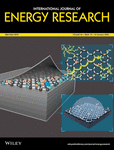Hydrogen evolution mechanism for Mg-H2O reaction in metal sulfate solutions and its application
Funding information: Science and Technology project of Hebei Education Department, Grant/Award Number: ZD 2020106
Summary
The reaction between Mg and H2O is slow at ambient temperature. Differently, hydrogen is rapidly evolved upon immersing Mg in MgSO4, CoSO4, and NiSO4 solutions at 303 K, and the hydrogen generation rates are ~40, 100, and 40 mL g−1 min−1, respectively. The H2 produced reacts with O2 in a fuel cell, generating a current of 200 to 500 mA. In CoSO4 solution, magnetic Co is separated, accompanied by heat release, inducing continued Mg-H2O reaction. However, little Ni is obtained during the entire process. In this case, the Mg(OH)2/Ni(OH)2 precipitate formed promotes water dissociation, and synergistic cooperation between the solution containing Mg2+ and SO42− and the freshly Mg(OH)2 accelerates H2 evolution. This study provides new insight for the reaction between metal and water in different salt solutions and for its application in fuel cell.
Open Research
DATA AVAILABILITY STATEMENT
All data that support the findings of this study are available from the corresponding author upon reasonable request.




